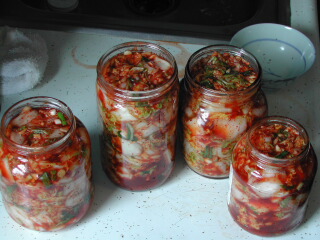Well, I grew up im the north woods of Minnesota, where there aren't any Koreans (or other people of color in general), so it was a bit difficult for my parents to get kimchi until the late 70s when a tiny market opened in St. Paul (4 1/2 hours away...). But once they got it, they stockpiled a bunch of it, always being careful to hide it if anyone came over, etc. But they ate it religiously with meals, and after a meal out, my dad would rush home (esp if it was a typical, fatty, northern Minnesota meal--what other kinds are there?) and eat a bunch of kimchi, declaring he hadn't eaten unless he'd had kimchi.
So of course I've had this "kimchi helps digestion" thing drilled into me, and it wasn't until recently that I found out it actually DOES have enzymes in it that help you digest food, wouldn't you know? And nappa cabbage is a natural source of lactobacillus probiotics, including the unusually hardy strain, l. plantarum. You can read all about the scientific validity here at this Cornell website, or you can just take my word for it.
 So get 1-2 heads nappa cabbage (also called Chinese cabbage) and please try to get organic because cabbage can be very pesticidey.
So get 1-2 heads nappa cabbage (also called Chinese cabbage) and please try to get organic because cabbage can be very pesticidey.(thank you to Jason
who takes much better pictures than
I do and loaned me some)
 Next assemble the following
Next assemble the following- 4-6 cloves of garlic
- 2-3 thumbs of ginger
- green onion and/or garlic chives ("buchu")
- sea salt NOT iodized (kosher is ok, too)
- red pepper flakes ("Gochukaro")
- daikon (optional but very healthy)
- carrots (optional)
- dab of raw honey

Wash and cut up the cabbage into bite sized pieces. Then sprinkle it in a large pot, adding salt between the layers, kind of like you're salting a roast or something.
Then put something heavy on top of it: clean plate, I have a clean stone from our sauerkraut maker.
Leave it overnight to squish out the water. Cabbage should be limp in the morning.

Taste the cabbage--it should be pleasantly salty. It's it's too-too salty, give it a quick rinse.
Stick it all in a bowl and add matchstick veggies . Mash the cloves of garlic and ginger (to taste) through a garlic press, food processor, or mince (I think mashing makes for better taste), add hot pepper.
My aunt uses sugar to get the cultures going, I use a dab of honey. You don't need to use anything at all. Mixing it with the hands is supposed to add a nice "vibe" to the whole thing. I always mix by hand.

Put the finished product in clean glass jars (the beauty of it, you don't need to sterilize, like you do for canning--the garlic and hot pepper keeps everything nice and clean). The color will depend on how much hot pepper you put in. The kimchi here is what it normally looks like (yum!). The picture of my cabbage in the bowl (previous picture) looks "weak" because I put in less pepper because I was making it for my son and didn't want the school calling DCYF on me for torturing my child (believe me, they already talk about the weird mommy who doesn't let her kid have ice cream).
Make sure you press all the air bubbles while you are packing it, so the cabbage will be immersed in juice. Swish about 1/4- 1/2 cu water around the bowl you made the kimchi in to get all the spices and stuff from the sides (recycling! reclamation!) and pour the mixture into the jars so that you have enough fluid. Leave about an inch, but no more, at the top, the close the lids. I put the jars on a tray because--if you did it right--in the fermentation, liquid might be pushed out the top of the jar.
Leave the whole thing out like a science project for 3-4 days and taste it. It should not be moldy or putrid, it should just taste pleasantly fermented--if tastes off (I've only had this happen once) it's because the stuff wasn't packed/immersed tightly enough or not enough salt/garlic. I know leaving food out can seem "unclean," but clever peoples learned to survive before Sub-zero refrigerators were invented**. Refrigerating it too soon will kill or slow the probiotics, so...chill out.
Some previous posts:







0 kommentarer:
Skicka en kommentar